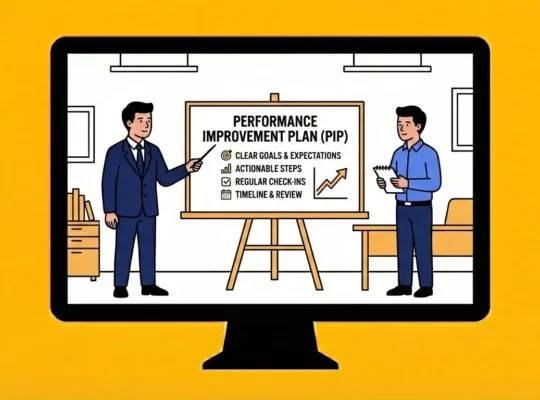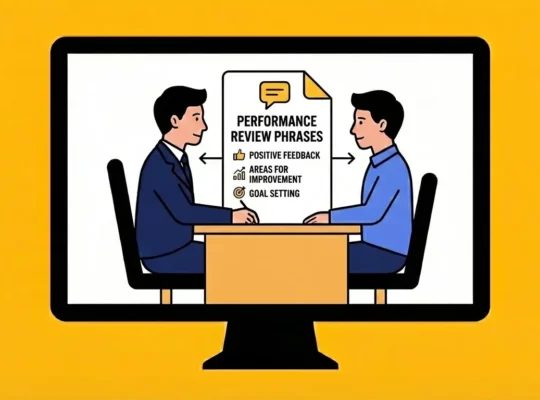Stay interview questions are a powerful tool for retaining your best employees. High turnover disrupts workflows, impacts morale, and eats into your bottom line. But how do you identify potential flight risks and address concerns before they lead to resignations? Enter the stay interview – a powerful tool for gauging employee satisfaction and proactively addressing issues that might lead them to leave.
At Review.jobs, we’re passionate about helping businesses cultivate a thriving work environment. We believe stay interviews are as important as any employee retention software when it comes to lowering turnover rates. This article delves into the world of stay interviews, exploring their purpose, benefits, and best practices.
- Understanding Stay Interviews
- Preparing for Stay Interviews
- 15 Key Stay Interview Questions to Ask
- Conducting Effective Stay Interviews
- Acting on Stay Interview Feedback
- Continuous Improvement with Review.jobs
I. Understanding Stay Interviews
Stay interviews are one-on-one meetings between a manager and an employee, focused on understanding what keeps the employee with the company and what might entice them to leave. Unlike exit interviews, which occur when an employee is already leaving, stay interviews are proactive. They help identify and address issues before they lead to turnover. Conducting stay interviews regularly can significantly enhance employee retention and engagement.
Definition and Purpose
A stay interview is a structured conversation aimed at uncovering what motivates employees to stay with your company and what might cause them to consider leaving. The primary purpose is to gather actionable insights to improve the work environment and address potential concerns before they escalate.
Difference Between Stay Interviews and Exit Interviews
While exit interviews provide insights after an employee has already left, stay interviews allow organizations to address potential issues before they escalate. By understanding what keeps employees engaged and motivated, companies can create a more positive and fulfilling work environment. This proactive approach allows organizations to address issues in real-time, fostering a more positive and engaging work environment.
Benefits of Conducting Stay Interviews Regularly
Stay interviews are a proactive approach to employee retention which yield substantial benefits for both employees and the organization.
Improved Retention
By identifying and addressing potential issues before they escalate, organizations can significantly reduce turnover rates.
Boosted Employee Engagement
Demonstrating a genuine interest in employee satisfaction fosters a stronger sense of connection and loyalty.
Enhanced Employee Experience
Regular stay interviews provide valuable insights into the employee experience, leading to targeted improvements in employee branding and the work environment.
Informed Decision Making
Data collected from stay interviews can inform strategic business decisions, such as talent development, resource allocation, and workplace enhancements.
Stronger Employer Brand
A positive employee experience translates into a strong employer brand, attracting top talent.
II. Preparing for Stay Interviews
Effective stay interviews require careful planning and execution. Here’s how to get started:
Identifying the Right Candidates for Stay Interviews
Carefully select employees for stay interviews, considering factors such as tenure, role, and performance. A diverse group of participants will provide a comprehensive view of the employee experience.
Timing and Frequency of Stay Interviews
Determine the frequency of stay interviews based on your company’s size and industry. Annual stay interviews are a good starting point, but consider more frequent check-ins for high-potential employees or those in critical roles.
Setting the Stage: Creating a Comfortable and Open Environment
Choose a private and comfortable setting for the interview. Reassure employees that their feedback is valued and will be used to improve the workplace. Establish confidentiality to encourage open and honest dialogue.
III. 15 Key Stay Interview Questions to Ask
Here are some essential stay interview questions categorized to cover different aspects of the employee experience:
General Questions
- What do you look forward to when you come to work each day?
- What do you like most and least about your job?
- What motivates you to stay with our company?
Job-Specific Questions
- What is the best part of your job, and how can we incorporate more of this?
- What challenges do you face in your current role?
- How can we support your career development?
Company Culture and Environment
- How do you feel about our company culture?
- What changes would you like to see in the workplace environment?
- How do you prefer to be recognized for your contributions?
Work-Life Balance and Flexibility
- What kinds of flexibility would be helpful to you in balancing work and home life?
- Are there any company policies or practices that you find particularly helpful or unhelpful?
- What additional support do you need to achieve a better work-life balance?
Future Outlook
- What talents or skills do you have that are not being utilized in your current role?
- What are your career goals, and how can we help you achieve them?
- What might tempt you to leave the company?
IV. Conducting Effective Stay Interviews
Stay interviews are a powerful tool for understanding employee satisfaction and identifying areas for improvement. To maximize their impact, follow these best practices:
Create a Safe and Trusting Environment
Foster open dialogue by assuring employees that their feedback is valued and will be used to enhance the workplace. Create a confidential space where employees feel comfortable sharing their honest thoughts and opinions without fear of repercussions.
Practice Active Listening and Empathy
Demonstrate a genuine interest in employees’ experiences by actively listening to their feedback. Pay attention to both verbal and non-verbal cues to fully understand their perspective. Show empathy and validate their feelings to build trust and encourage open communication.
Capture and Analyze Feedback
Document key points and recurring themes during the interview to identify patterns and trends. Use this information to develop actionable strategies for improvement. Analyze feedback to understand the root causes of employee satisfaction or dissatisfaction.
V. Acting on Stay Interview Feedback
Gathering valuable feedback is essential, but it’s only the first step. To truly improve employee satisfaction and retention, organizations must act on the insights gained from stay interviews.
Identify Key Themes and Areas for Improvement
To transform feedback into actionable improvements, it’s essential to delve deeper into the data. By carefully analyzing stay interview responses, you can uncover recurring themes and pinpoint areas for targeted action.
Key steps in this process include:
- Categorizing Feedback: Group similar responses into specific themes, such as work-life balance, career growth, management style, compensation, and company culture.
- Identifying Patterns: Look for recurring patterns within each theme to understand the scope and impact of the issue.
- Prioritizing Actions: Based on the frequency and severity of issues, determine which areas require immediate attention and develop a prioritization plan.
- Quantifying Feedback: Where possible, use metrics to measure the impact of identified problems. This data can help justify resource allocation for improvement initiatives.
Develop and Implement Action Plans
Once you’ve identified key areas for improvement based on stay interview feedback, it’s time to develop and implement actionable plans.
To craft an effective action plan:
- Involve Stakeholders: Collaborate with relevant departments and team members to ensure buy-in and expertise.
- Set Clear Objectives: Define specific, measurable, achievable, relevant, and time-bound (SMART) goals for each action plan.
- Assign Responsibilities: Clearly outline who is responsible for each action and establish accountability.
- Allocate Resources: Determine the necessary budget, personnel, and tools to support plan implementation.
- Establish a Timeline: Set realistic deadlines for each action step and create a project timeline.
- Monitor Progress: Regularly track progress and adjust plans as needed to ensure successful implementation.
Communicate and Follow Through
Open communication is essential for building trust and demonstrating a commitment to employee well-being.
- Transparency is Key: Keep employees informed about the actions being taken in response to their feedback. Regular updates, whether through company-wide announcements, team meetings, or individual conversations, show that their input is valued.
- Celebrate Successes: Publicly recognize and celebrate the positive outcomes resulting from employee feedback. This reinforces the message that their input makes a difference.
- Be Honest About Challenges: If implementation takes longer than expected or faces obstacles, be transparent about the situation. Explain the reasons for delays and outline the steps being taken to overcome challenges.
- Create a Feedback Loop: Encourage ongoing feedback by providing multiple channels for employees to share their thoughts and suggestions.
VI. Continuous Improvement with Review.jobs
Effective stay interviews are a continuous process, not a one-time event. Here’s how employee feedback tools, such as Review.jobs, can empower you to maintain momentum and build a culture of ongoing feedback:
Foster a Culture of Anonymous Feedback
Stay interviews offer valuable insights, but sometimes employees may hesitate to share everything in a face-to-face setting. Collecting anonymous feedback allows employees to provide candid feedback at their own pace. This can help identify deeper issues or concerns that surface readily in a more anonymous environment.
Harness Data-Driven Action Plans
Review.jobs offers powerful tools to analyze employee feedback. These tools can help you identify trends, categorize concerns, and prioritize areas for improvement. Data-driven insights enable you to develop actionable plans that address the most pressing employee needs.
Continuous Improvement and Refinement
The stay interview process should be an evolving practice. Use feedback from employees and the data gathered through Review.jobs to refine your approach. Consider adjusting your interview questions, incorporating new feedback channels, or tailoring the process to different employee groups. By embracing continuous improvement, you demonstrate a commitment to creating a workplace that meets the ever-changing needs of your team.
Incorporating stay interviews into your regular HR practices can significantly improve employee retention and engagement. By understanding and addressing the needs of your employees, you create a more positive and productive work environment. At Review.jobs, we are committed to helping you achieve this goal. Share your experiences with stay interviews and any additional questions you might have in the comments below. Together, we can make your company a great place to work.





